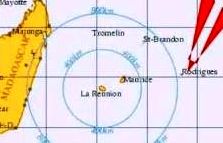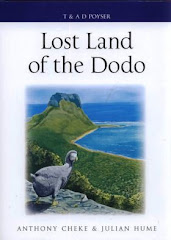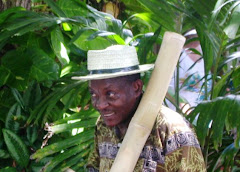 East coast of Japan - Freydis, red and named after the daughter of Erich the Viking- She made more than 248 000 sea miles, built in 1978/79
East coast of Japan - Freydis, red and named after the daughter of Erich the Viking- She made more than 248 000 sea miles, built in 1978/79Am Montag bekam ich ein e-mail von unseren Freunden Heide und Erich Wilts, dass ihr Boot
Freydis am Freitag von dem Tsunami in Japan verschlungen wurde. Wir hatten die beiden vor ca. 10 Jahren hier in Rodrigues kennengelernt, als sie Zwischenstation für einen Törn mit Mitseglern nach St.Brandon und Reunion vorbereitet haben, von wo es dann weiter nach Südafrika gehen sollte. Wir haben immer wieder ihre Routen verfolgt, die sie in die entlegensten Gebiete zwischen den Polen geführt haben. Die Freydis ist ein Boot mit Geschichte, wie wohl selten eines. Viel Dramatisches hat sie schon hinter sich gebracht, mehrfach war sie totgeglaubt, doch immer wieder stand sie auf.
-On Monday I got an e-mail from our friends Heide and Erich Wilts, that their sailing boat Freydis was swallowed by the tsunami in Japan. We met the German couple about 10 years ago here in Rodrigues, as they prepared for a cruise to South Africa with a stopover at St.Brandon and Reunion. Ever since we have followed their routes which led them to the most remote areas between the poles. The Freydis is a boat with history, a history quite out of the ordinary too. She had been several times in dramatic situations, and several times she was believed to be dead, but every time she got up.
Doch nun zu der Geschichte, die gestern einen unerwarteten Verlauf nahm....Hier ein Artikel, der heute in der Emdener Zeitung veröffentlicht wurde, mit einigen Zusatzangaben bzw. Fotos aus Erichs und Heides Blog.
-
But now to the story, which took an unexpected turn yesterday .... Here is an article that was published today in a German newspaper, some additional information and photos are from Erich and Heide's Blog.
Erst vernichtet, dann wieder aufgetaucht -
First destroyed, then resurfaced...
Von EZ-Redakteur AXEL MILKERTS
Iwaki/Heidelberg.
Innerhalb einer unvorstellbaren Tragödie wie der in Japan gibt es auch die vergleichsweise kleinen persönlichen Katastrophen. Eine solche ist dem gebürtigen Leeraner Erich Wilts und seiner Frau Heide (beide 69) widerfahren. Ihr Boot, die „Freydis II”, ist allem Anschein nach ein Opfer von Erdbeben, Tsunami und atomarer Strahlung geworden.
Dabei erlebte das Ehepaar gestern und am Montag eine emotionale Achterbahnfahrt. Sie hatten ihr gut 14 Meter langes Weltumseglungsboot im vergangenen Jahr in der Iwaki-Sun-Marina in Iwaki zwischengeparkt. Von dort wollten sie zum nächsten Törn aufbrechen, der sie – als erstes Boot dieser Art überhaupt – nach Kamtschatka führen würde. Es war alles vorbereitet. Dann kam das Erdbeben.-
Within an unimaginable tragedy like that in Japan there are also personal disasters, small in comparison but with a lot of impact for the ones affected. Such as the one which happened to Erich Wilts, native to Leer, and his wife Heide (both 69) . Their boat, the "Freydis II ", has apparently become a victim of the earthquake, tsunami and nuclear radiation.
Yesterday and on Monday the couple went here through an emotional roller coaster ride. Last year they had "parked" their yacht of about 14 meter length in the Iwaki-Sun Marina in Iwaki. From there they had intended to leave for the next project, leading them to Kamchatka - as the first boat of this kind at all. It was prepared for everything. Then the earthquake happened.
Iwaki Sun Marina- Freydis' mooring & overwintering place before she was supposed to sail again via Kamtchatka to Alaska in June after some overhauling
Erich und Heide Wilts erhielten am vergangenen Sonntag eine E-Mail aus Iwaki. Darin erfuhren sie: Die Marina ist vollständig zerstört und die „Freydis II” sei weggespült worden. Gestern dann meldete sich der Chefredakteur einer japanischen Seglerzeitschrift, die einmal über das deutsche Boot berichtet hatte. Ein Leser habe das Boot entdeckt. Und der schickte auch gleich ein Foto mit. Die „Freydis II” liegt an einem Felsen unweit von Iwaki, offensichtlich noch recht gut in Schuss.-
Sunday they received an e-mail from Iwaki. They learned that the marina was completely destroyed and that the "Freydis II" had been washed away. Yesterday then another e-mail: the chief editor of a Japanese sailor magazine that once had reported on the German boat wrote that a reader had discovered the boat. And he sent even a photo. The "Freydis II is situated at a cliff near Iwaki, obviously still in better shape than one could expect.

A miracle: found 4 days after the tsunami with the mast still up
„Wir haben geheult, als wir das gesehen haben”, sagte Erich Wilts im Gespräch mit der Emder Zeitung. Das Boot ist „ein wesentlicher Teil” im Leben der beiden Segelenthusiasten, die auch in Emden schon mit ihren Vorträgen begeisterten.
Über 248 000 Seemeilen haben sie mit ihrem Boot seit 1979 absolviert. Das sind elfeinhalb Erdumrundungen. Die Törns führten unter anderem in die Antarktis, nach Südamerika und in den Nordpazifik. Sämtliche Reisen, auch die mit der ersten „Freydis”, begannen in Leer.
Erich und Heide Wilts – sie ist gebürtig aus Stuttgart und ehemalige Oberärztin der Ammerland-Klinik in Westerstede – wollen weitermachen, auch wenn beiden klar ist, dass ihr buchstäblich wieder aufgetauchtes Boot nicht mehr zu retten sein wird. Iwaki liegt zwei Autostunden südöstlich der havarierten Kernkraftwerke von Fukushima.-
"We cried when we saw that, " said Erich Wilts in conversation with the Emden newspaper. The boat is a "substantial part" in the lives of the two sailing enthusiasts, who had fascinated in the past also the local people from Emden with the accounts of their circumnavigations.
Over 248 000 nautical miles they have completed with their boat since 1979. This makes eleven and a half times around the world. The trips led them - beside others- to Antarctica, South America and the North Pacific. All voyages, also the ones on "Freydis I, " began in Leer.
Erich and Heide Wilts - she is a native of Stuttgart and a former senior doctor of Ammerland clinic in Westerstede - will continue, even though both realize that their literally again surfaced boat probably can't be saved. Iwaki is located two hours southeast of the damaged nuclear power plants from Fukushima.

Freydis Position is now Misaki, Onahama, Iwaki city - so she flow about 4 km north east.
Es soll wieder ein Boot her. Ein kostspieliges Unterfangen. Müsste er die „Freydis II” nachbauen, würde man heute mit 500 000 Euro nicht mehr hinkommen, sagte Erich Wilts. Sie werden arbeiten, um ihre Segelträume weiter zu leben, kündigte er an. Denn bis 75, sagte Erich Wilts, wolle er schon noch weitermachen. Arbeiten, das heißt vor allem: Vorträge halten. Das Ehepaar, das inzwischen in Heidelberg lebt, wird dann demnächst vermutlich auch in Emden wieder zu sehen und zu hören sein.
Bei allem Schmerz über den Verlust der „Freydis II” sind ihre Gedanken bei den Menschen in Japan. „Auch Freunde von uns wurden bereits evakuiert”, weiß Erich Wilts. Ken Ando, der Chefredakteur der Seglerzeitschrift, nennt es „ein Wunder”, dass das deutsche Segelboot kaum Schaden genommen hat. Seine E-Mail schließt mit den Worten: „Die Menschen in Japan verlieren die Hoffnung nicht.”-
Another boat has to be built. A costly endeavor. Reconstructing a boat like "Freydis II", will certainly not be possible any more with 500 000 €, Erich Wilts said. They will work to continue to live their sailing dreams, he announced. As up to 75, he would like to go on. Work, that is, above all, giving lectures. The couple, who now lives in Heidelberg, can probably soon be seen and heard again in Emden.
Beside all the pain over the loss of "Freydis II", their thoughts are with the people of Japan. "Even friends of ours have already been evacuated, "says Erich Wilts. Ken Ando, the editor of the sailing magazine, calls it "a miracle" that the German sailing boat hasn't been damaged more. His e-mail ends with the words: "People in Japan do not lose hope."
Erich und Heide Wilts who do not want to give up on living their sailing dreams
Sources:- Emder Zeitung Originalseite/ (Download PDF, 800 KB)- Erich & Heide Wilt's Freydis Blog, Freydis website - Article on blog here with more related links to other newspaper articles featuring the story such as













































